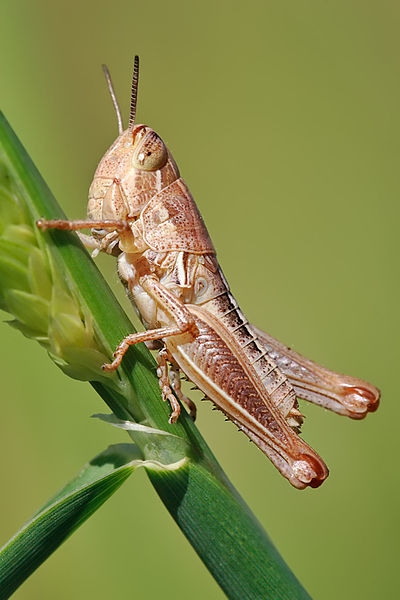UC Blogs
It's a good year for grasshoppers
A wet spring in 2011 set the stage for a grasshopper invasion in 2012, according to a story on KNVN News, the NBC affiliate in Northern California.
"Last year was a nice wet year, lots of feed. We had a chance for the population to build up. They lay eggs in the fall, those hatch in the spring so we got a lot more hoppers this year," said Joe Connell, UC Cooperative Extension advisor and county director in Butte County.
Grasshoppers can strip vegetable crops and vegetable gardens, Connell said. One of the best ways to protect the garden is to have a lush, green grassy area separate from the garden.
"You can either spray with a carbaryl insecticide or bait it with grasshopper bait, which can control their population," Connell said.
Gardeners who don't want to use insecticides can try buying chickens or guinea hens to keep grasshoppers under control.
Know Your Sticks
Entomologists at the Bohart Museum of Entomology at the University of California, Davis, want you to “know your sticks.” So,...
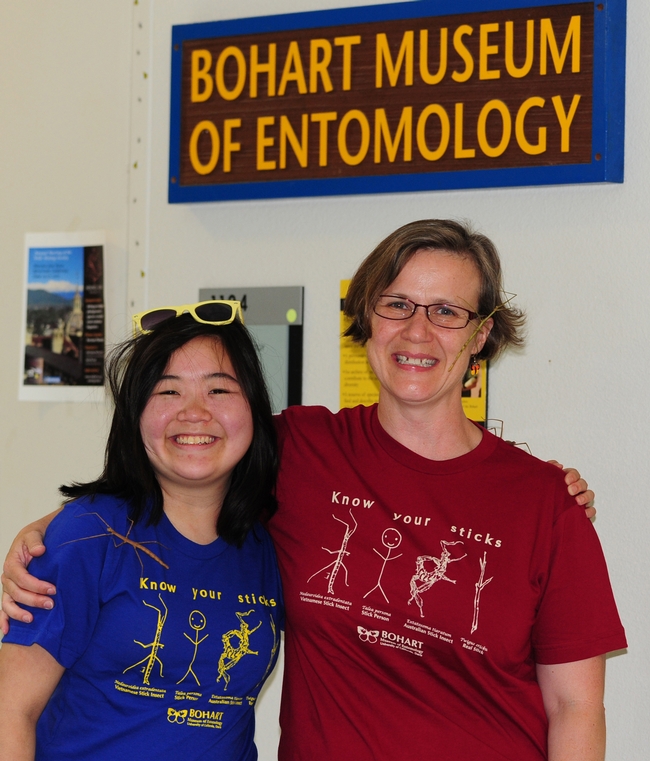
Ivana Li (left) and Fran Keller wearing their "Know Your Sticks" t-shirts. Note the real walking stick insects. (Photo by Kathy Keatley Garvey)
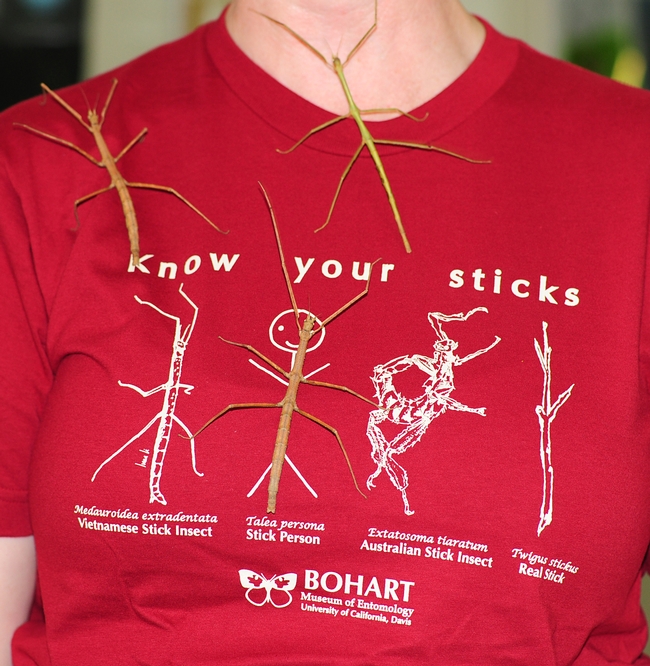
Check out the stick on the stick, second from left. (Photo by Kathy Keatley Garvey)
Western Farm Press runs 1,000-word story on Kearney blueberry event
The annual Blueberry Open House at the UC Kearney Agricultural Research and Extension Center last month warranted lengthy coverage by Western Farm Press.
Freelance writer Dennis Pollock reported that Manuel Jimenez, UC Cooperative Extension advisor in Tulare County, a small-scale farming expert, walked among the mature blueberry plants at Kearney, describing their good points and bad points.
"The perfect blueberry would be one that is big, firm, sweet, easy to harvest and grows in high pH (soil conditions)," he said.
At the event, Richard Molinar, UCCE advisor in Fresno County, small-scale farming, conducted a blueberry tasting, allowing those who attended to vote for their favorite three varieties. He said that variety isn't the only factor impacting flavor.
"Flavor is also affected by weather, soil factors, plant nutrition and irrigation frequency," Molinar said.
Jimenez introduced growers to two new research projects in blueberries:
- Jimenez and Larry Schwankl, Kearney-based UCCE irrigation specialist in the UC Davis Department of Land, Air and Water Resources, have teamed to study the effects of varying irrigation levels on blueberries.
- Jimenez has grafted popular blueberry varieties onto the roots of farkleberry (Viccinium abroreum), which has greater tolerance of alkaline soils like those found in the San Joaquin Valley. By reducing or eliminating soil and water acidification, using the alternate rootstock may provide a significant cut in production costs.
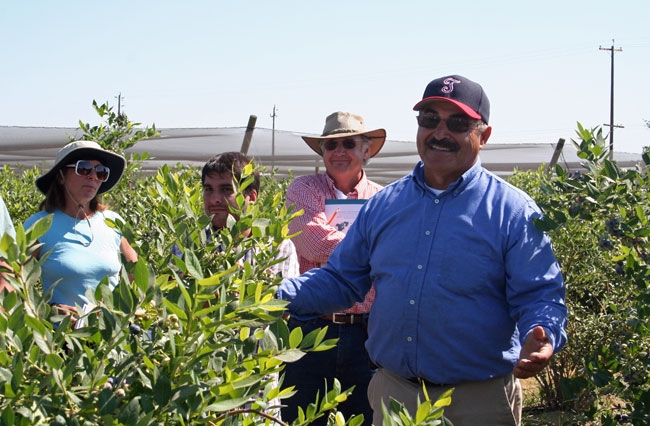
Manuel Jimenez leads a tour of the 15-year-old blueberry research plot.
Urban Homesteading Tour
Urban homesteading has been picking up speed, especially in the Bay Area, in the past few years. People, both young and old, are re-discovering skills once regarded as common knowledge by our grandparents and the generations before them. Skills such as tending a garden, growing edibles, cooking, keeping bees, raising animals (e.g., chickens and goats) cheese making, canning, preserving and fermenting foods from the garden, and basic carpentry, are all making a come-back. Indeed, urban homesteading has become so popular, that even mainstream corporate America has caught on. The posh San Francisco-based retailer, Williams-Sonoma, has even taken notice and developed their own line of homesteading products called “Agrarian” (I won’t go into it here, but that move has been met with controversy among urban homesteaders).
While there are a great number of resources on urban homesteading, for those starting out and wondering if this lifestyle is for them, the Institute on Urban Homesteading located in Oakland, California, is offering a (paid but affordable) tour of 7 different urban farms/gardens located at private residences in the East Bay on June 9, 2012 from 11 am - 5 pm. I had the pleasure of attending a tour of 3 urban farms last year to observe the creativity and ingenuity of people who squeeze utility out of every inch of their urban space to grow and raise their own food sustainably (see pictures below). Although utility tends to come first in managing an urban farm/garden, with beauty secondary, some of the urban farms on the tour were/are as beautiful as they were/are useful.
For more information, see http://iuhoakland.com/events.html .
Outstanding Entomologist
Ivana Li's fascinations with insects began in early childhood. She delighted in the insects on her parents' rose buses--the aphids, the ...
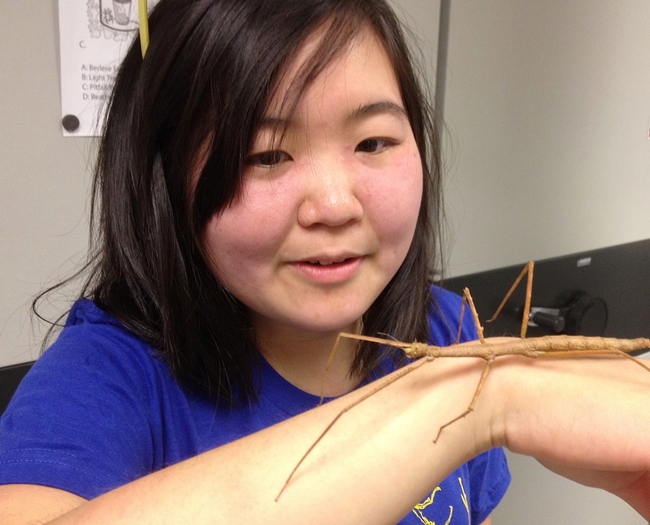
Ivana Li with a walking stick. (Photo by Fran Keller, Bohart Museum of Entomology)


